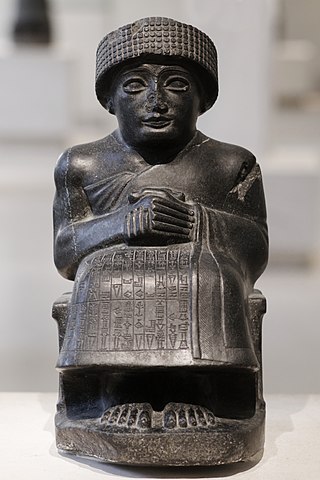Top Qs
Timeline
Chat
Perspective
Gudea
Sumerian king of Lagash (died c. 2124 BC) From Wikipedia, the free encyclopedia
Remove ads
Gudea (/ɡuː.ˈdeɪ.ə/, goo-DAY-ə; Sumerian: 𒅗𒌤𒀀, Gu3-de2-a; died c. 2124 BC) was a Sumerian ruler (ensi) of the state of Lagash in Southern Mesopotamia, who ruled or c. 2144–2124 BC (MC). Though most likely not a native of Lagash, he married Ninalla, the daughter of its ruler Ur-Baba, which enabled him to enter the royal family. He was succeeded by his son, Ur-Ningirsu II. Gudea ruled during a period when the Gutian dynasty Mari.[1] Under Gudea, Lagash experienced a golden age, with seemingly considerable independence from the Gutians, a language isolate populace who had came from northeastern regions beyond Mesopotamia.[2]
Remove ads
Inscriptions
Summarize
Perspective


Gudea chose the title of énsi (town-king or governor), not the more exalted lugal (Akkadian šarrum). Gudea did not style himself "god of Lagash" as he was not deified during his own lifetime, this title must have been given to him posthumously[4] as in accordance with Mesopotamian traditions for all rulers except Naram-Sin of Akkad and some of the Ur III kings.[5]
The 20 years of his reign are all known by name; the main military exploit seems to have occurred in his Year 6, called the "Year when Anshan was smitten with weapons".[6]
Although Gudea claimed to have conquered Elam and Anshan, most of his inscriptions emphasize the building of irrigation channels and temples, and the creation of precious gifts to the gods.[7]
Materials for his buildings and statues were brought from all parts of western Asia: cedar wood from the Amanus mountains, quarried stones from Lebanon, copper from northern Arabia, gold and precious stones from the desert between Canaan and Egypt, diorite from Magan (Oman), and timber from Dilmun (Bahrain).[8][9][10]
Remove ads
Statues of Gudea


Religion
Summarize
Perspective




The inscription on a statue of Gudea as architect of the House of Ningirsu,[11] warns the reader of doom if the words are altered, but there is a startling difference between the warnings of Sargon or his line and the warnings of Gudea. The one is length; Gudea's curse lasts nearly a quarter of the inscription's considerable length,[12] and another is creativity. The gods will not merely reduce the offender's progeny to ash and destroy his foundations, no, they will, "let him sit down in the dust instead of on the seat they set up for him". He will be "slaughtered like a bull… seized like an aurochs by his fierce horn".[13]
Lagash under Gudea had extensive commercial communications with distant realms. According to his own records, Gudea brought cedars from the Amanus and Lebanon mountains in Syria, diorite from eastern Arabia, copper and gold from central and southern Arabia and from Sinai, while his armies were engaged in battles in Elam on the east.[14]
International relations

In an inscription, Gudea referred to the Meluhhans who came to Sumer to sell gold dust, carnelian etc...[14] In another inscription, he mentioned his victory over the territories of Magan, Meluhha, Elam and Amurru.[14]
In the Gudea cylinders, Gudea mentions that "I will spread in the world respect for my Temple, under my name the whole universe will gather in it, and Magan and Meluhha will come down from their mountains to attend" (cylinder A, IX).[15] In cylinder B, XIV, he mentions his procurement of "blocks of lapis lazuli and bright carnelian from Meluhha."[16]
The first known reference to Goa in India possibly appears as Gubi in the records of Gudea.[17] At the time, Sumerians had established trade contacts with India.[17]
Remove ads
Important artifacts
- The "Libation vase of Gudea" with the dragon Mušḫuššu, dedicated to Ningishzida (21st century BC). The caduceus (right) is interpreted as depicting god Ningishzida. Inscription; "To the god Ningiszida, his god, Gudea, Ensi (governor) of Lagash, for the prolongation of his life, has dedicated this."
- Head of Gudea in polished diorite, reign of Gudea (Boston Museum of Fine Arts)
- Lion macehead of Gudea, Girsu[18]
- Gudea tablet: "For Hendursaga, his master, Gudea, ruler of Lagash, built his house."[19] Vorderasiatisches Museum, Berlin.
- Foundation nail of Gudea, Cleveland Museum of Art
- Name and title "Gudea, ensi of Lagash" on Statue A of Gudea
- Foundation nail for the temple of Ningirsu in Lagash. Reign of Gudea.
- Mudbrick stamped with a cuneiform text mentioning the name of Gudea, ruler of Lagash. From Girsu, Iraq, c. 2115 BC. Vorderasiatisches Museum, Berlin
- Seal of Gudea, led by Ningishzida
Remove ads
References
Sources
External links
Wikiwand - on
Seamless Wikipedia browsing. On steroids.
Remove ads













